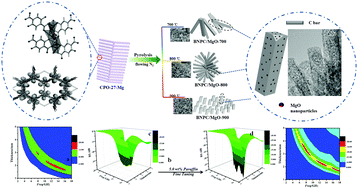Thermal conversion of wheat-like metal organic frameworks to achieve MgO/carbon composites with tunable morphology and microwave response†
Abstract
Dielectric materials are essential parts of microwave absorbers due to their good chemical stability, low density and excellent microwave dissipation. How to enhance their complex permittivity has been a research focus. The dielectric constant is closely related to polarization and conduction. There are many pathways to boost polarization behaviors and electrical conductivity, so hybrid methods are very common to realize integration of multiple loss mechanisms. However, there are inevitable issues such as heterogeneous distribution of particles, rugged interfaces, and poor repeatability. Here, we report a simple thermal conversion strategy to enable magnesium oxide to be embedded in a graphitized carbon matrix. With variation of heating conditions, a nanoporous carbon texture with different morphologies and distinct conductivity can be obtained, which is beneficial to enhanced polarization processes as well as conduction attenuation. Thus, the obtained nanocomposites can achieve controllable performances, such as extension of effective bandwidth, a shift of maximum absorbing peaks towards low frequencies, and lightweight characteristics. These findings provide new insights into the application potential of metal organic frameworks (MOFs); in addition, our method offers a good case study of a rational design to complete numerous optimization strategies.



 Please wait while we load your content...
Please wait while we load your content...